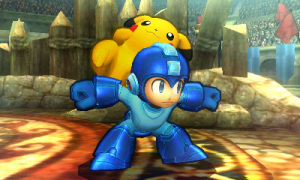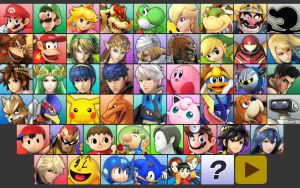In a little more than a month from the publication of this review the Wii U version of Smash Bros will arrive on US shores, but in the meantime there is Super Smash Bros. for Nintendo 3DS to occupy Smash fans. The inclusion of a handheld version of a previously console-only game was something clearly considered from the outset, and it was asked of a development team that has considerable experience producing for the 3DS. So has the fourth entry in the illustrious Smash series been adapted successfully to the portable world? In many regards, yes. But ultimately the experience is left feeling like a limited paired down version of a main course yet to come.
Avid fans of the series were likely wary of the prospects for a handheld version of this title, with considerable doubt surrounding the fitness of the platform to simply control the game. The 3DS’s limited control scheme, featuring a circle pad instead of a full analogue stick and no second directional input at all, would mean the controlability of the game would likely suffer in order to fit onto a 3DS. This fear has indeed panned out, as the controls do operate and offer almost all of the same control the previous entries afforded, but do so only just serviceably. The circle pad, which tends to feel less like an input device and more like sliding a penny around on a table, along with the thin rectangular profile of the console, can easily lead to hand cramping and soreness after less than a half hour’s play time. The shoulder buttons can be out of place, particularly the L Button, when otherwise attempting to maintain a comfortable grip on the console. This button’s considerable importance, being the grab button and thereby making up a good third of gameplay strategy, means a continued shifting of grip on the device. The upper screen’s propensity to wobble with the slightest movement only exacerbates this issue. It becomes clearer by the hour that a game as twitch-based as Smash is a rough fit a best in comparison to the calmer affair of RPG inputs that otherwise occupy this reviewer’s time with the device.
The game’s content is, at first blush, no slouch in the variety department. Along with traditional Smash modes there is the return of a Classic progression mode, All Star mode, some mini games in the Stadium menu, and the all new Smash Run alongside a more filled out online experience. The omission from the previous game is the detestable Subspace Emissary, the curiously named and over-wrought single player “story mode” that attempted to turn a 2D brawler into a platformer with some kind of plot. Any such pretenses have been (mostly) dropped this time around, with some of those cumbersome platforming elements making their return in the new Smash Run. The problems with this new mode are many, not the least of which is the large time commitment spent running around a massive map collecting specific power-ups for about five minutes only to end up in a competition that requires more speed than knockback power. No early warning is made of the powered-up match to follow so the wrongly speced will likely fail through little fault of their own. The online mode is a better offer over the last game’s, but only just. Open match-making is still just essentially an anonymous hook-up service aimed at getting the deed done and moving on, and the impersonal nature of it grows increasingly at odds with the personal nature of the Nintendo ecosystem. In the face of such blank online participation, it is little wonder the developer has historically seen no merit in it. But such shortcomings are by their own design, an apparently deliberate hampering of friendly anonymous online interaction. The mode’s attraction is further hurt by the considerable input lag and gameplay hiccups that can plague about half of all matches. The inclusion of a core-friendly For Glory item-less mode only soothes that problem so much.
The competitive scene has taken a close eye to this game more with the intent to glean early speculation about the home console version’s fitness for competition than to further the 3DS version’s use in something like tournament play. Doubtless there are some among the crowd who think the 3DS a good enough fit for this, and Nintendo’s own tournament hostings seem to reenforce those delusions. The truth is that this game will be largely abandoned by competitive players for a console version that offers better control and likely better stability online or otherwise. However, some important information has been uncovered that will impact the home console release. In particular some of the game’s mechanics that govern DI, hitstun and knockback power at higher damage percentages have been proven to be changed dramatically. DI is still a factor, thankfully, but it is now calculated in a way that necessarily changes how inputs should be made. Early speculation is that this will make surviving with this mechanic much easier. Hitstun and knockback are both changed by the addition of a rage system that increasingly powers up characters over a certain damage percentage. This means more vulnerable characters will have the ability to deal more damage with higher knockback, essentially an attempt to level the playing field. The reality is that these buffed characters will suffer more in competitive play, as their stronger attacks will knock opponents out of their comboing range. Characters that have been hit less will have their combos preserved for longer, potentially punishing characters at high damage in a way not intended. The combo potential of the game does seem greater than Brawl‘s by a long shot, with certain standouts like Sheik and Rosalina making early bids for high tier, but any observations of their performance must be recognized as through the lens of a limited control scheme.
The roster on offer this time is of note if only for its massiveness. Previously so called “clone” characters that shared the same moveset animations had been a staple since Melee, and the differences were sometimes more than most players could appreciate. This time around the differences between entrants like Pit and Dark Pit have been made even more unclear. Time will likely resolve the differences, as it did the differences between the otherwise identical Mario and Dr. Mario, but it puts a feeling of bloat upon the roster for the first time in the series. Third party appearances are still in, this time with Pac-Man and Mega Man (minus Solid Snake from Metal Gear Solid) and the returning Sonic. A long term examination is required for many aspects of a game like this, but initial impressions lead the roster to feel full of samey characters in a game that has probably reached or surpassed its ideal maximum roster count.
Ultimately Super Smash Bros. for Nintendo 3DS attempts to serve up a handheld experience that improves upon its predecessor, but only opens up new problems by dint of its platform of choice. The home console version will likely see many of these complaints ameliorated to some extent, if not fully. Casual fans of Smash with an interest the game’s portability will see a lot of usage out this title, but all others are best served by waiting for the main course to arrive.


